Establishing Project Aims and Objectives for Equality and Diversity in the Workplace
VerifiedAdded on 2023/01/12
|17
|4135
|29
AI Summary
This document discusses the process of establishing project aims and objectives for equality and diversity in the workplace. It explores the importance of maintaining equity and diversity in the workforce, the challenges faced by organizations, and strategies to overcome these challenges. The document also includes a work breakdown structure and Gantt chart for the project.
Contribute Materials
Your contribution can guide someone’s learning journey. Share your
documents today.
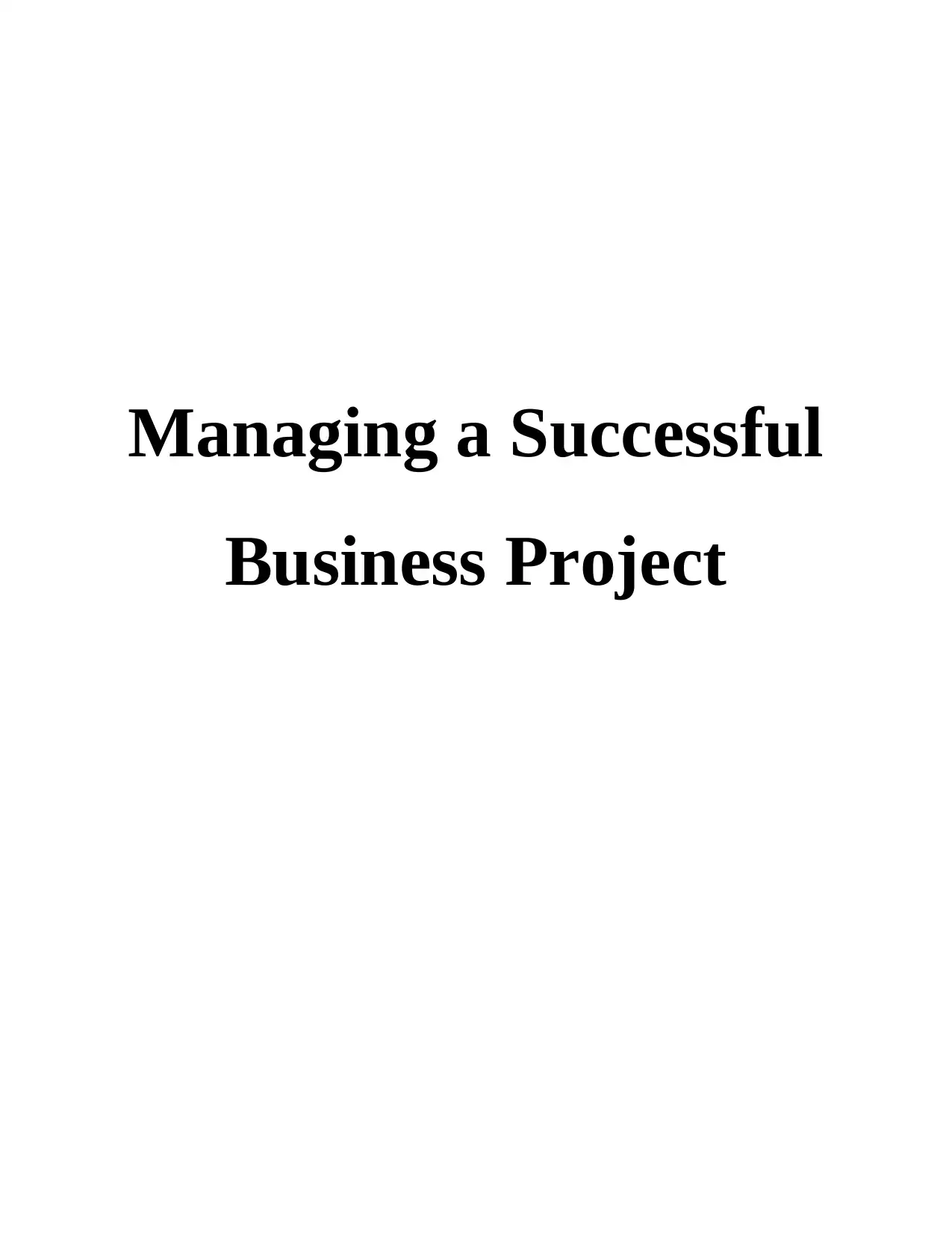
Managing a Successful
Business Project
Business Project
Secure Best Marks with AI Grader
Need help grading? Try our AI Grader for instant feedback on your assignments.
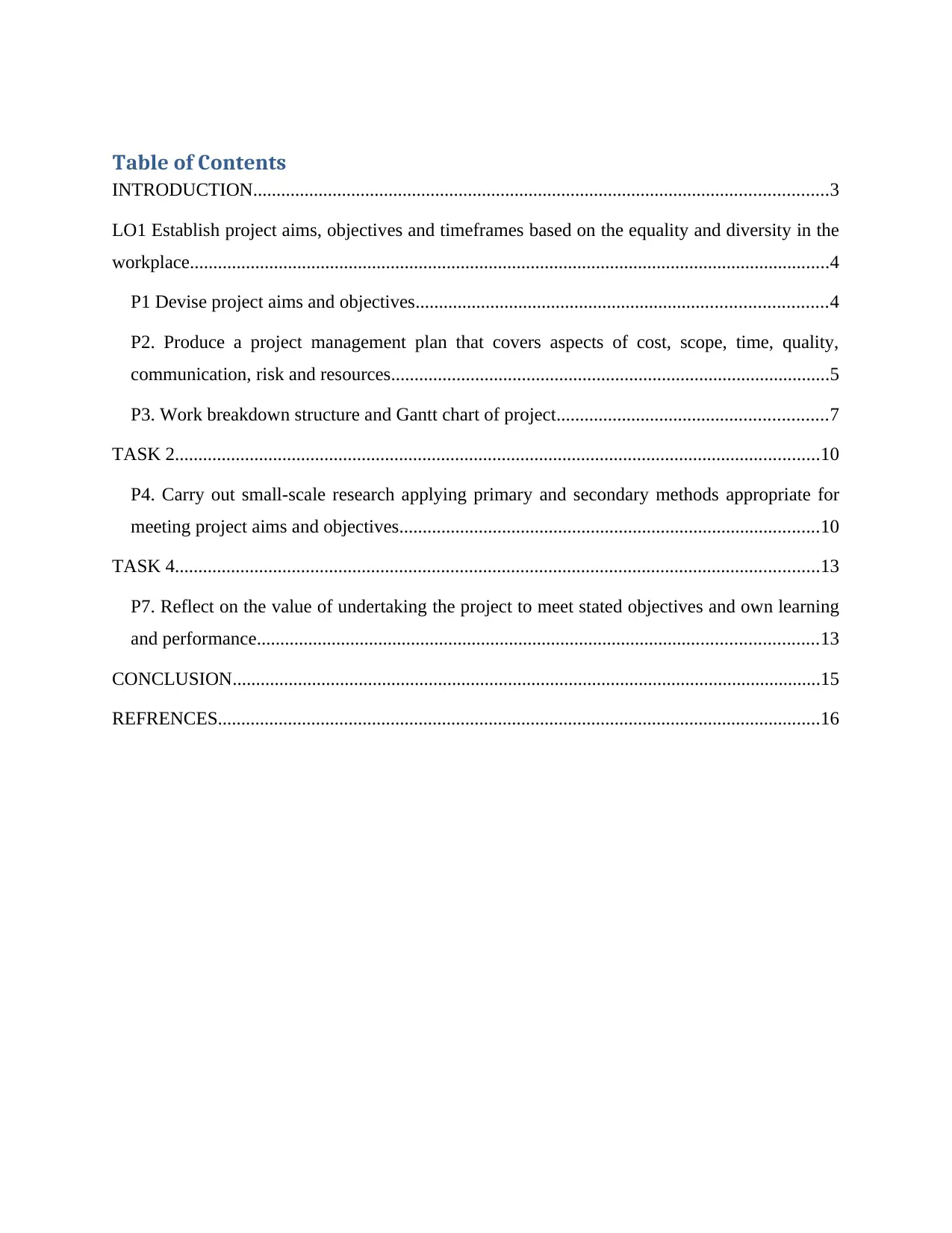
Table of Contents
INTRODUCTION...........................................................................................................................3
LO1 Establish project aims, objectives and timeframes based on the equality and diversity in the
workplace.........................................................................................................................................4
P1 Devise project aims and objectives........................................................................................4
P2. Produce a project management plan that covers aspects of cost, scope, time, quality,
communication, risk and resources..............................................................................................5
P3. Work breakdown structure and Gantt chart of project..........................................................7
TASK 2..........................................................................................................................................10
P4. Carry out small-scale research applying primary and secondary methods appropriate for
meeting project aims and objectives..........................................................................................10
TASK 4..........................................................................................................................................13
P7. Reflect on the value of undertaking the project to meet stated objectives and own learning
and performance........................................................................................................................13
CONCLUSION..............................................................................................................................15
REFRENCES.................................................................................................................................16
INTRODUCTION...........................................................................................................................3
LO1 Establish project aims, objectives and timeframes based on the equality and diversity in the
workplace.........................................................................................................................................4
P1 Devise project aims and objectives........................................................................................4
P2. Produce a project management plan that covers aspects of cost, scope, time, quality,
communication, risk and resources..............................................................................................5
P3. Work breakdown structure and Gantt chart of project..........................................................7
TASK 2..........................................................................................................................................10
P4. Carry out small-scale research applying primary and secondary methods appropriate for
meeting project aims and objectives..........................................................................................10
TASK 4..........................................................................................................................................13
P7. Reflect on the value of undertaking the project to meet stated objectives and own learning
and performance........................................................................................................................13
CONCLUSION..............................................................................................................................15
REFRENCES.................................................................................................................................16
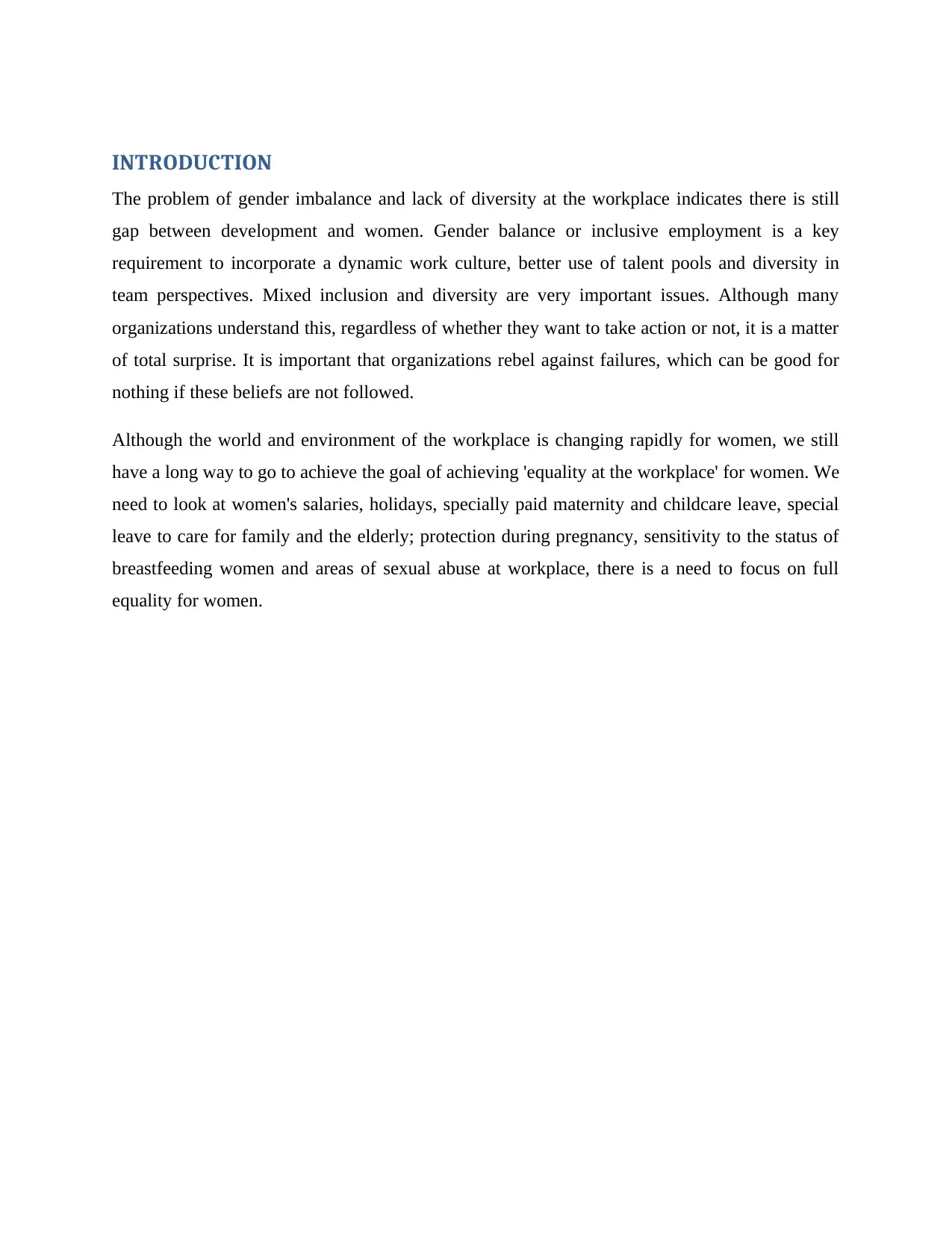
INTRODUCTION
The problem of gender imbalance and lack of diversity at the workplace indicates there is still
gap between development and women. Gender balance or inclusive employment is a key
requirement to incorporate a dynamic work culture, better use of talent pools and diversity in
team perspectives. Mixed inclusion and diversity are very important issues. Although many
organizations understand this, regardless of whether they want to take action or not, it is a matter
of total surprise. It is important that organizations rebel against failures, which can be good for
nothing if these beliefs are not followed.
Although the world and environment of the workplace is changing rapidly for women, we still
have a long way to go to achieve the goal of achieving 'equality at the workplace' for women. We
need to look at women's salaries, holidays, specially paid maternity and childcare leave, special
leave to care for family and the elderly; protection during pregnancy, sensitivity to the status of
breastfeeding women and areas of sexual abuse at workplace, there is a need to focus on full
equality for women.
The problem of gender imbalance and lack of diversity at the workplace indicates there is still
gap between development and women. Gender balance or inclusive employment is a key
requirement to incorporate a dynamic work culture, better use of talent pools and diversity in
team perspectives. Mixed inclusion and diversity are very important issues. Although many
organizations understand this, regardless of whether they want to take action or not, it is a matter
of total surprise. It is important that organizations rebel against failures, which can be good for
nothing if these beliefs are not followed.
Although the world and environment of the workplace is changing rapidly for women, we still
have a long way to go to achieve the goal of achieving 'equality at the workplace' for women. We
need to look at women's salaries, holidays, specially paid maternity and childcare leave, special
leave to care for family and the elderly; protection during pregnancy, sensitivity to the status of
breastfeeding women and areas of sexual abuse at workplace, there is a need to focus on full
equality for women.
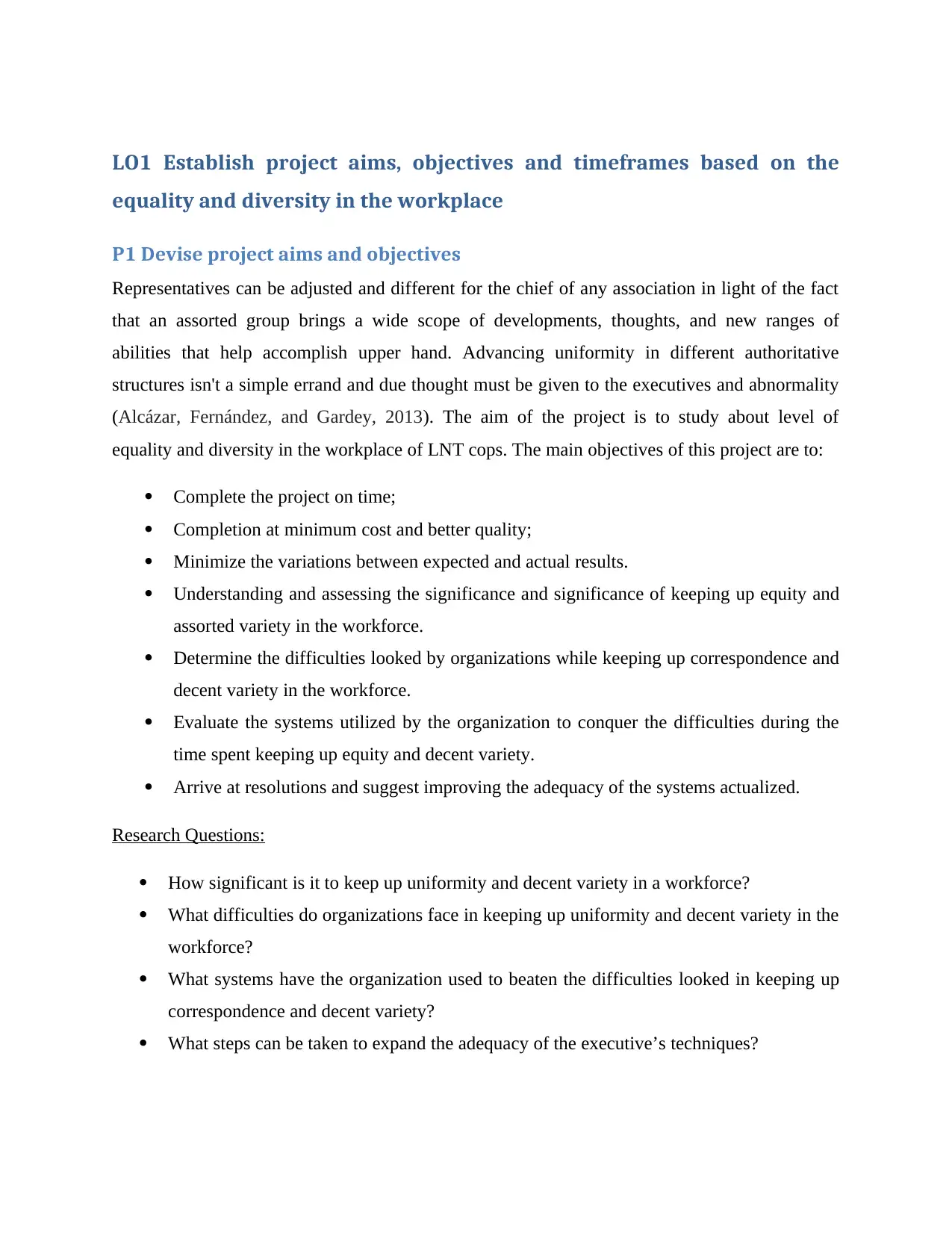
LO1 Establish project aims, objectives and timeframes based on the
equality and diversity in the workplace
P1 Devise project aims and objectives
Representatives can be adjusted and different for the chief of any association in light of the fact
that an assorted group brings a wide scope of developments, thoughts, and new ranges of
abilities that help accomplish upper hand. Advancing uniformity in different authoritative
structures isn't a simple errand and due thought must be given to the executives and abnormality
(Alcázar, Fernández, and Gardey, 2013). The aim of the project is to study about level of
equality and diversity in the workplace of LNT cops. The main objectives of this project are to:
Complete the project on time;
Completion at minimum cost and better quality;
Minimize the variations between expected and actual results.
Understanding and assessing the significance and significance of keeping up equity and
assorted variety in the workforce.
Determine the difficulties looked by organizations while keeping up correspondence and
decent variety in the workforce.
Evaluate the systems utilized by the organization to conquer the difficulties during the
time spent keeping up equity and decent variety.
Arrive at resolutions and suggest improving the adequacy of the systems actualized.
Research Questions:
How significant is it to keep up uniformity and decent variety in a workforce?
What difficulties do organizations face in keeping up uniformity and decent variety in the
workforce?
What systems have the organization used to beaten the difficulties looked in keeping up
correspondence and decent variety?
What steps can be taken to expand the adequacy of the executive’s techniques?
equality and diversity in the workplace
P1 Devise project aims and objectives
Representatives can be adjusted and different for the chief of any association in light of the fact
that an assorted group brings a wide scope of developments, thoughts, and new ranges of
abilities that help accomplish upper hand. Advancing uniformity in different authoritative
structures isn't a simple errand and due thought must be given to the executives and abnormality
(Alcázar, Fernández, and Gardey, 2013). The aim of the project is to study about level of
equality and diversity in the workplace of LNT cops. The main objectives of this project are to:
Complete the project on time;
Completion at minimum cost and better quality;
Minimize the variations between expected and actual results.
Understanding and assessing the significance and significance of keeping up equity and
assorted variety in the workforce.
Determine the difficulties looked by organizations while keeping up correspondence and
decent variety in the workforce.
Evaluate the systems utilized by the organization to conquer the difficulties during the
time spent keeping up equity and decent variety.
Arrive at resolutions and suggest improving the adequacy of the systems actualized.
Research Questions:
How significant is it to keep up uniformity and decent variety in a workforce?
What difficulties do organizations face in keeping up uniformity and decent variety in the
workforce?
What systems have the organization used to beaten the difficulties looked in keeping up
correspondence and decent variety?
What steps can be taken to expand the adequacy of the executive’s techniques?
Secure Best Marks with AI Grader
Need help grading? Try our AI Grader for instant feedback on your assignments.
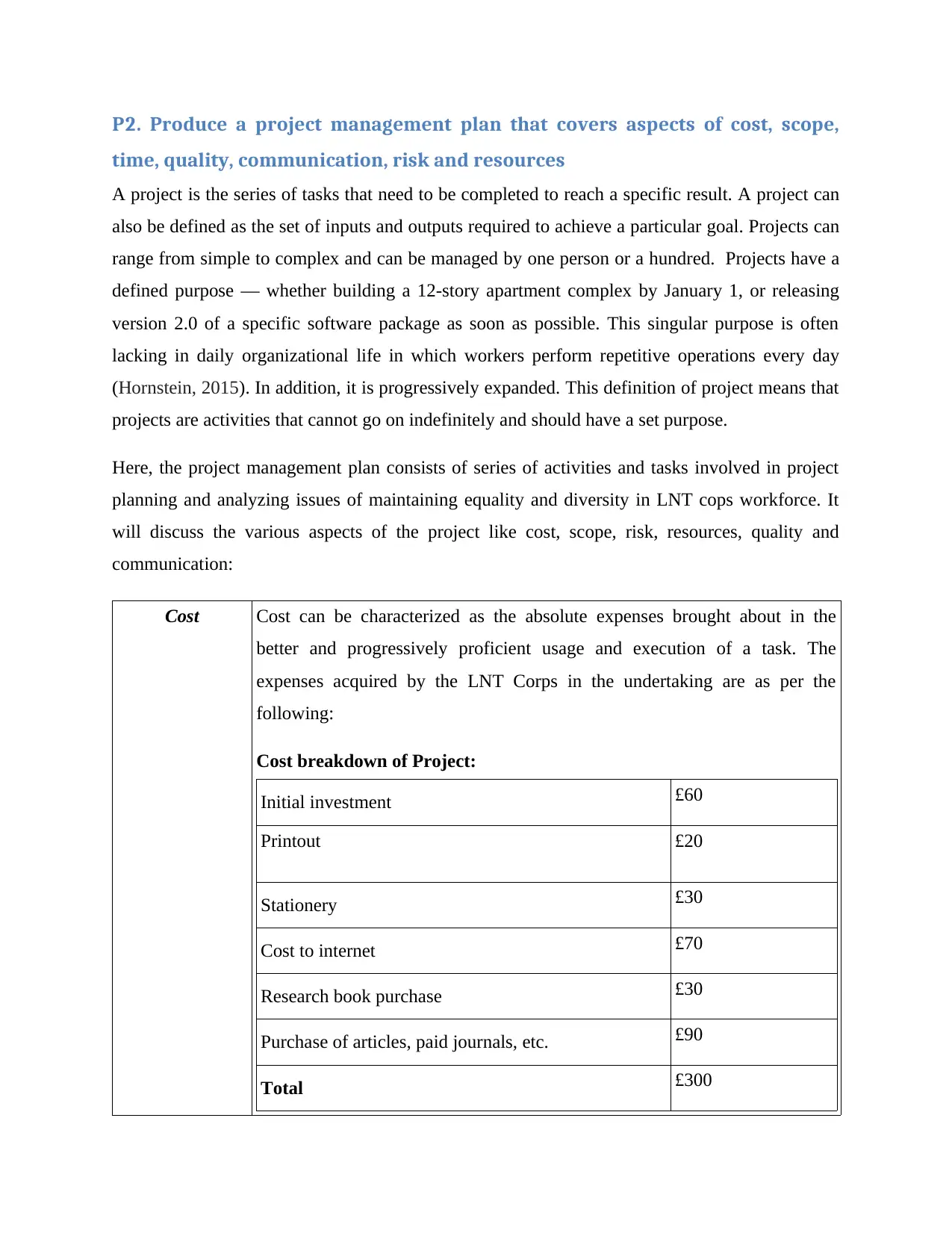
P2. Produce a project management plan that covers aspects of cost, scope,
time, quality, communication, risk and resources
A project is the series of tasks that need to be completed to reach a specific result. A project can
also be defined as the set of inputs and outputs required to achieve a particular goal. Projects can
range from simple to complex and can be managed by one person or a hundred. Projects have a
defined purpose — whether building a 12-story apartment complex by January 1, or releasing
version 2.0 of a specific software package as soon as possible. This singular purpose is often
lacking in daily organizational life in which workers perform repetitive operations every day
(Hornstein, 2015). In addition, it is progressively expanded. This definition of project means that
projects are activities that cannot go on indefinitely and should have a set purpose.
Here, the project management plan consists of series of activities and tasks involved in project
planning and analyzing issues of maintaining equality and diversity in LNT cops workforce. It
will discuss the various aspects of the project like cost, scope, risk, resources, quality and
communication:
Cost Cost can be characterized as the absolute expenses brought about in the
better and progressively proficient usage and execution of a task. The
expenses acquired by the LNT Corps in the undertaking are as per the
following:
Cost breakdown of Project:
Initial investment £60
Printout £20
Stationery £30
Cost to internet £70
Research book purchase £30
Purchase of articles, paid journals, etc. £90
Total £300
time, quality, communication, risk and resources
A project is the series of tasks that need to be completed to reach a specific result. A project can
also be defined as the set of inputs and outputs required to achieve a particular goal. Projects can
range from simple to complex and can be managed by one person or a hundred. Projects have a
defined purpose — whether building a 12-story apartment complex by January 1, or releasing
version 2.0 of a specific software package as soon as possible. This singular purpose is often
lacking in daily organizational life in which workers perform repetitive operations every day
(Hornstein, 2015). In addition, it is progressively expanded. This definition of project means that
projects are activities that cannot go on indefinitely and should have a set purpose.
Here, the project management plan consists of series of activities and tasks involved in project
planning and analyzing issues of maintaining equality and diversity in LNT cops workforce. It
will discuss the various aspects of the project like cost, scope, risk, resources, quality and
communication:
Cost Cost can be characterized as the absolute expenses brought about in the
better and progressively proficient usage and execution of a task. The
expenses acquired by the LNT Corps in the undertaking are as per the
following:
Cost breakdown of Project:
Initial investment £60
Printout £20
Stationery £30
Cost to internet £70
Research book purchase £30
Purchase of articles, paid journals, etc. £90
Total £300

Scope Depicts the proper degree of territory or subject. The extent of this
exploration is extremely wide and enables the specialist to find the
significance and significance of equity and assorted variety in staff and
serves to plainly distinguish issues. Also, challenges in the process with
procedures utilized by the association to beat those difficulties (Samantara
and Sharma, 2014).
Time Time decides the beginning and end of an undertaking. It is imperative to
comprehend the significance of time as far as succession of occasions to
complete an undertaking. The proposed timetable for compelling execution
and fruition of this undertaking is roughly a month and a half.
Quality The project's quality plan should determine the quality standards of the
project and determine how the project is making quality plans and
arrangements while these items are meant to achieve quality standards.
The quality plan of the project is one of the outcomes of quality planning. As
long as it sets these standards, procedures and quality standards associated
with the project, to whom and what resources should be used. The result of
the project's quality plan works: The quality inspection checklist can be used
for other management information, project quality plan, project quality job
description (Jeston and Nelis, 2014).
Communication Communication is extremely important in any relationship. Lack of
communication creates many problems that only increase with time. It is
often said that if there is a problem, one should talk to someone about it, if it
is a happy moment, share it, if you are sad then tell it to someone close to
you. Communication is of utmost importance in any situation. It strengthens
the bond between people.
Risk Project Risk Management Plans think about these ideas that can identify,
anticipate, and resolve solutions in terms of running projects into problems /
problems. A good project risk management plan can withstand unexpected
problems arising, as the planner has taken into account all possible scenarios
exploration is extremely wide and enables the specialist to find the
significance and significance of equity and assorted variety in staff and
serves to plainly distinguish issues. Also, challenges in the process with
procedures utilized by the association to beat those difficulties (Samantara
and Sharma, 2014).
Time Time decides the beginning and end of an undertaking. It is imperative to
comprehend the significance of time as far as succession of occasions to
complete an undertaking. The proposed timetable for compelling execution
and fruition of this undertaking is roughly a month and a half.
Quality The project's quality plan should determine the quality standards of the
project and determine how the project is making quality plans and
arrangements while these items are meant to achieve quality standards.
The quality plan of the project is one of the outcomes of quality planning. As
long as it sets these standards, procedures and quality standards associated
with the project, to whom and what resources should be used. The result of
the project's quality plan works: The quality inspection checklist can be used
for other management information, project quality plan, project quality job
description (Jeston and Nelis, 2014).
Communication Communication is extremely important in any relationship. Lack of
communication creates many problems that only increase with time. It is
often said that if there is a problem, one should talk to someone about it, if it
is a happy moment, share it, if you are sad then tell it to someone close to
you. Communication is of utmost importance in any situation. It strengthens
the bond between people.
Risk Project Risk Management Plans think about these ideas that can identify,
anticipate, and resolve solutions in terms of running projects into problems /
problems. A good project risk management plan can withstand unexpected
problems arising, as the planner has taken into account all possible scenarios
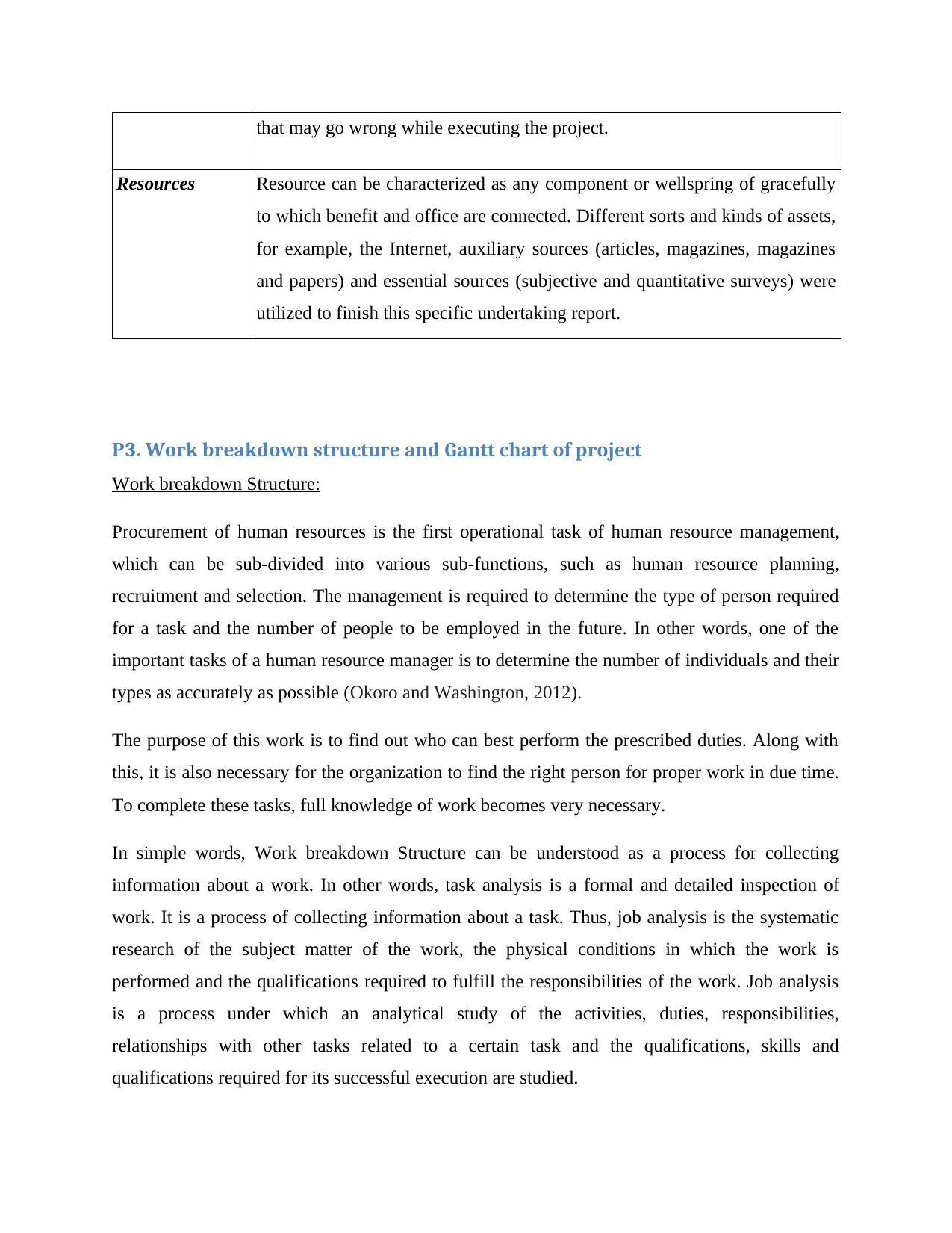
that may go wrong while executing the project.
Resources Resource can be characterized as any component or wellspring of gracefully
to which benefit and office are connected. Different sorts and kinds of assets,
for example, the Internet, auxiliary sources (articles, magazines, magazines
and papers) and essential sources (subjective and quantitative surveys) were
utilized to finish this specific undertaking report.
P3. Work breakdown structure and Gantt chart of project
Work breakdown Structure:
Procurement of human resources is the first operational task of human resource management,
which can be sub-divided into various sub-functions, such as human resource planning,
recruitment and selection. The management is required to determine the type of person required
for a task and the number of people to be employed in the future. In other words, one of the
important tasks of a human resource manager is to determine the number of individuals and their
types as accurately as possible (Okoro and Washington, 2012).
The purpose of this work is to find out who can best perform the prescribed duties. Along with
this, it is also necessary for the organization to find the right person for proper work in due time.
To complete these tasks, full knowledge of work becomes very necessary.
In simple words, Work breakdown Structure can be understood as a process for collecting
information about a work. In other words, task analysis is a formal and detailed inspection of
work. It is a process of collecting information about a task. Thus, job analysis is the systematic
research of the subject matter of the work, the physical conditions in which the work is
performed and the qualifications required to fulfill the responsibilities of the work. Job analysis
is a process under which an analytical study of the activities, duties, responsibilities,
relationships with other tasks related to a certain task and the qualifications, skills and
qualifications required for its successful execution are studied.
Resources Resource can be characterized as any component or wellspring of gracefully
to which benefit and office are connected. Different sorts and kinds of assets,
for example, the Internet, auxiliary sources (articles, magazines, magazines
and papers) and essential sources (subjective and quantitative surveys) were
utilized to finish this specific undertaking report.
P3. Work breakdown structure and Gantt chart of project
Work breakdown Structure:
Procurement of human resources is the first operational task of human resource management,
which can be sub-divided into various sub-functions, such as human resource planning,
recruitment and selection. The management is required to determine the type of person required
for a task and the number of people to be employed in the future. In other words, one of the
important tasks of a human resource manager is to determine the number of individuals and their
types as accurately as possible (Okoro and Washington, 2012).
The purpose of this work is to find out who can best perform the prescribed duties. Along with
this, it is also necessary for the organization to find the right person for proper work in due time.
To complete these tasks, full knowledge of work becomes very necessary.
In simple words, Work breakdown Structure can be understood as a process for collecting
information about a work. In other words, task analysis is a formal and detailed inspection of
work. It is a process of collecting information about a task. Thus, job analysis is the systematic
research of the subject matter of the work, the physical conditions in which the work is
performed and the qualifications required to fulfill the responsibilities of the work. Job analysis
is a process under which an analytical study of the activities, duties, responsibilities,
relationships with other tasks related to a certain task and the qualifications, skills and
qualifications required for its successful execution are studied.
Paraphrase This Document
Need a fresh take? Get an instant paraphrase of this document with our AI Paraphraser
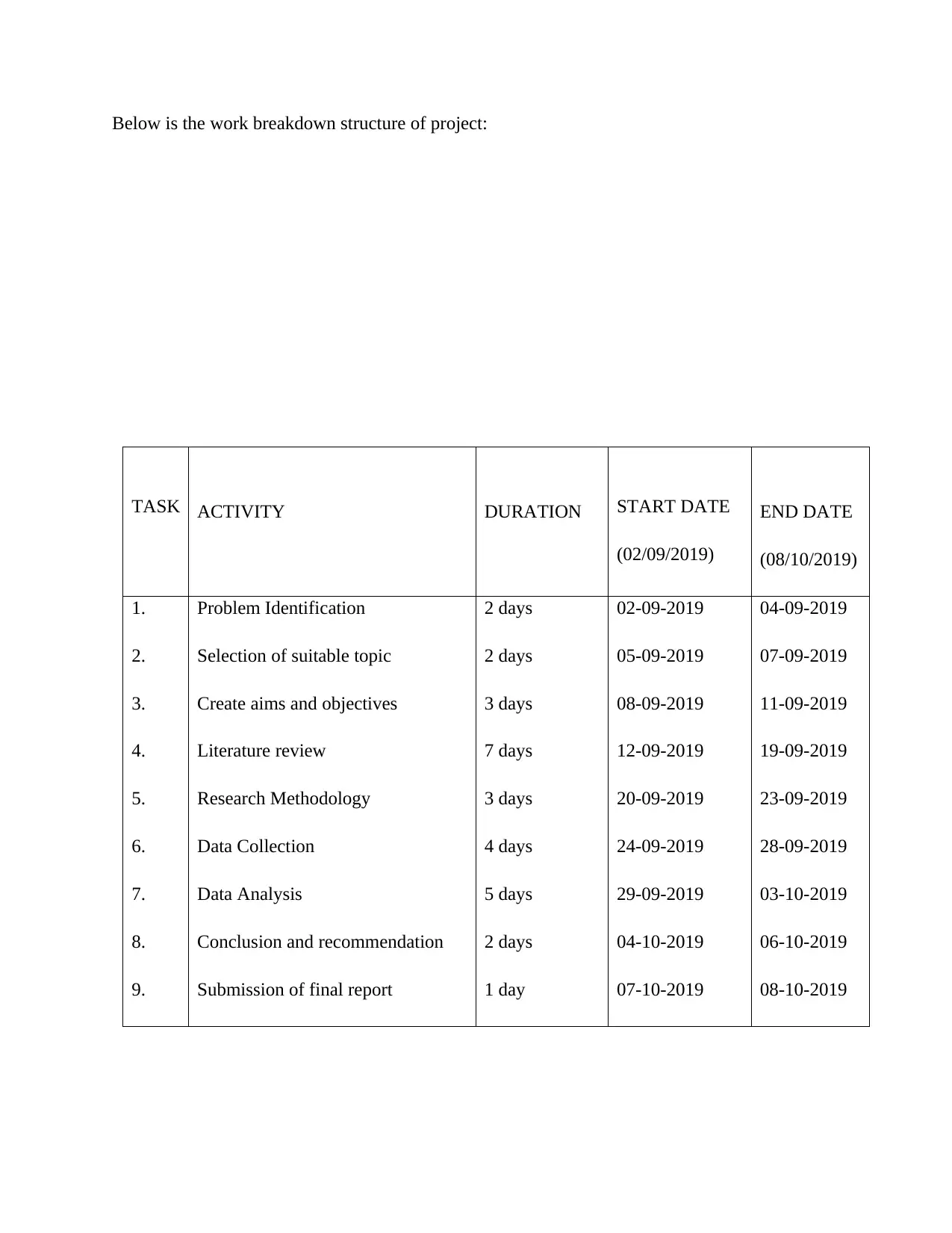
Below is the work breakdown structure of project:
TASK ACTIVITY DURATION START DATE
(02/09/2019)
END DATE
(08/10/2019)
1.
2.
3.
4.
5.
6.
7.
8.
9.
Problem Identification
Selection of suitable topic
Create aims and objectives
Literature review
Research Methodology
Data Collection
Data Analysis
Conclusion and recommendation
Submission of final report
2 days
2 days
3 days
7 days
3 days
4 days
5 days
2 days
1 day
02-09-2019
05-09-2019
08-09-2019
12-09-2019
20-09-2019
24-09-2019
29-09-2019
04-10-2019
07-10-2019
04-09-2019
07-09-2019
11-09-2019
19-09-2019
23-09-2019
28-09-2019
03-10-2019
06-10-2019
08-10-2019
TASK ACTIVITY DURATION START DATE
(02/09/2019)
END DATE
(08/10/2019)
1.
2.
3.
4.
5.
6.
7.
8.
9.
Problem Identification
Selection of suitable topic
Create aims and objectives
Literature review
Research Methodology
Data Collection
Data Analysis
Conclusion and recommendation
Submission of final report
2 days
2 days
3 days
7 days
3 days
4 days
5 days
2 days
1 day
02-09-2019
05-09-2019
08-09-2019
12-09-2019
20-09-2019
24-09-2019
29-09-2019
04-10-2019
07-10-2019
04-09-2019
07-09-2019
11-09-2019
19-09-2019
23-09-2019
28-09-2019
03-10-2019
06-10-2019
08-10-2019
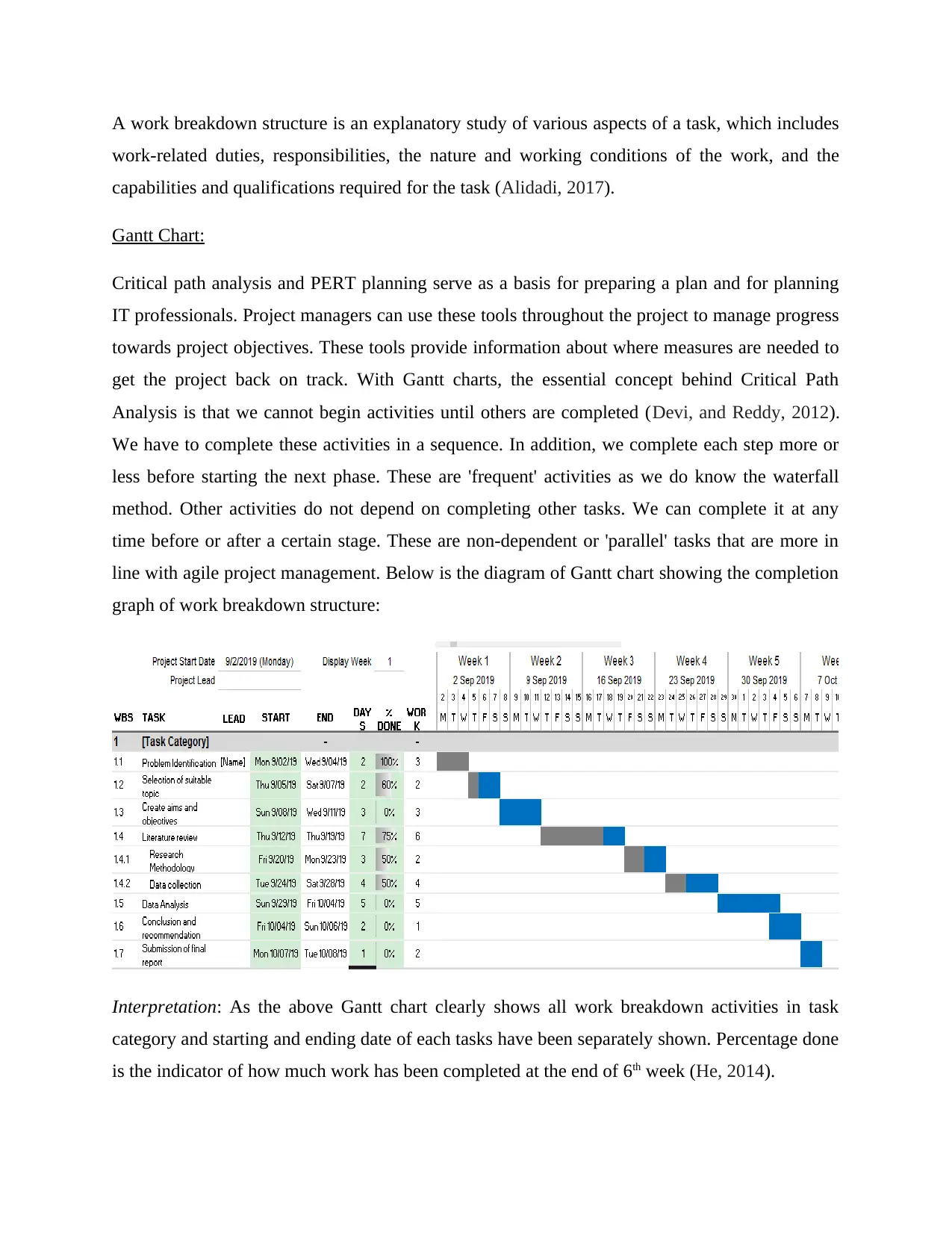
A work breakdown structure is an explanatory study of various aspects of a task, which includes
work-related duties, responsibilities, the nature and working conditions of the work, and the
capabilities and qualifications required for the task (Alidadi, 2017).
Gantt Chart:
Critical path analysis and PERT planning serve as a basis for preparing a plan and for planning
IT professionals. Project managers can use these tools throughout the project to manage progress
towards project objectives. These tools provide information about where measures are needed to
get the project back on track. With Gantt charts, the essential concept behind Critical Path
Analysis is that we cannot begin activities until others are completed (Devi, and Reddy, 2012).
We have to complete these activities in a sequence. In addition, we complete each step more or
less before starting the next phase. These are 'frequent' activities as we do know the waterfall
method. Other activities do not depend on completing other tasks. We can complete it at any
time before or after a certain stage. These are non-dependent or 'parallel' tasks that are more in
line with agile project management. Below is the diagram of Gantt chart showing the completion
graph of work breakdown structure:
Interpretation: As the above Gantt chart clearly shows all work breakdown activities in task
category and starting and ending date of each tasks have been separately shown. Percentage done
is the indicator of how much work has been completed at the end of 6th week (He, 2014).
work-related duties, responsibilities, the nature and working conditions of the work, and the
capabilities and qualifications required for the task (Alidadi, 2017).
Gantt Chart:
Critical path analysis and PERT planning serve as a basis for preparing a plan and for planning
IT professionals. Project managers can use these tools throughout the project to manage progress
towards project objectives. These tools provide information about where measures are needed to
get the project back on track. With Gantt charts, the essential concept behind Critical Path
Analysis is that we cannot begin activities until others are completed (Devi, and Reddy, 2012).
We have to complete these activities in a sequence. In addition, we complete each step more or
less before starting the next phase. These are 'frequent' activities as we do know the waterfall
method. Other activities do not depend on completing other tasks. We can complete it at any
time before or after a certain stage. These are non-dependent or 'parallel' tasks that are more in
line with agile project management. Below is the diagram of Gantt chart showing the completion
graph of work breakdown structure:
Interpretation: As the above Gantt chart clearly shows all work breakdown activities in task
category and starting and ending date of each tasks have been separately shown. Percentage done
is the indicator of how much work has been completed at the end of 6th week (He, 2014).
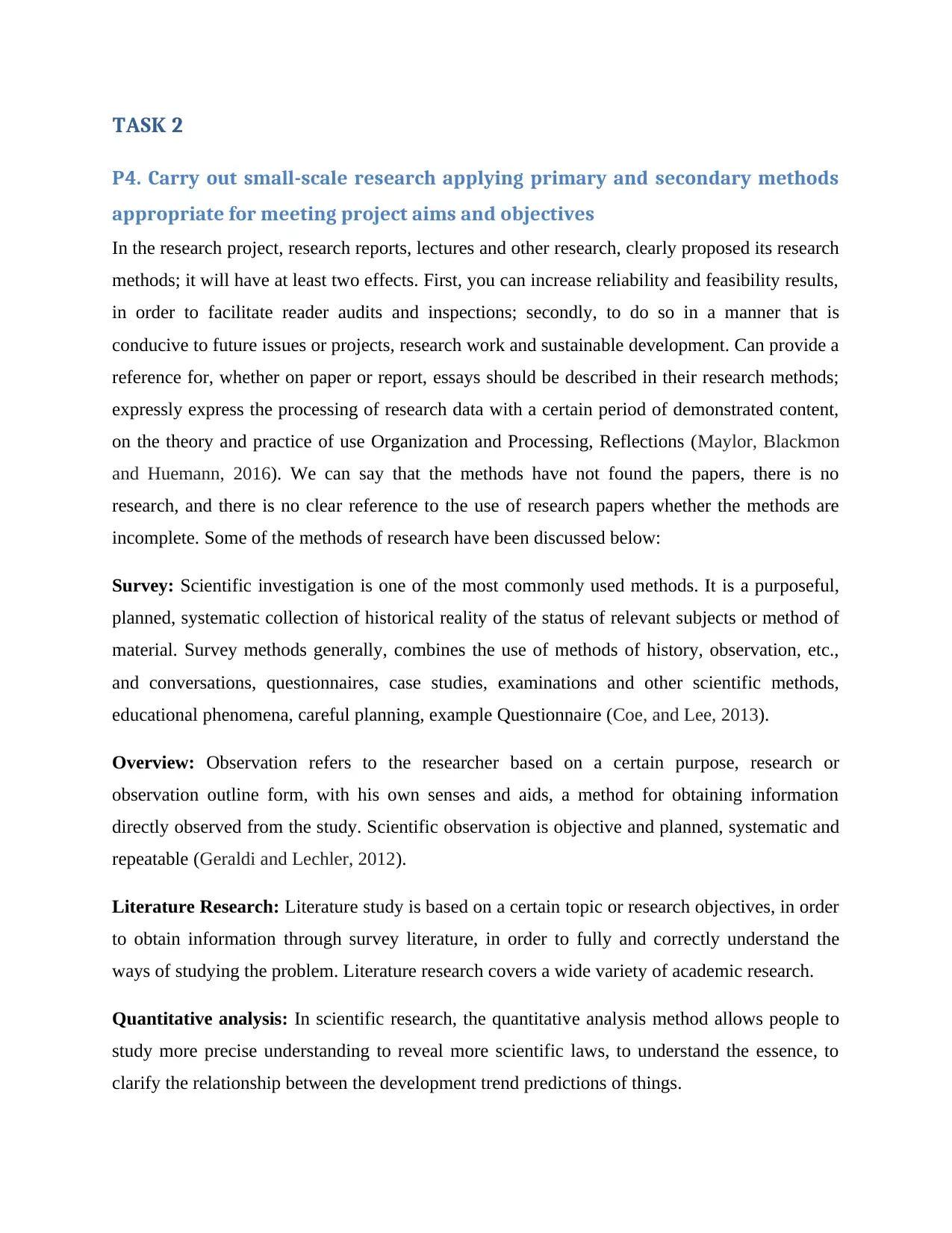
TASK 2
P4. Carry out small-scale research applying primary and secondary methods
appropriate for meeting project aims and objectives
In the research project, research reports, lectures and other research, clearly proposed its research
methods; it will have at least two effects. First, you can increase reliability and feasibility results,
in order to facilitate reader audits and inspections; secondly, to do so in a manner that is
conducive to future issues or projects, research work and sustainable development. Can provide a
reference for, whether on paper or report, essays should be described in their research methods;
expressly express the processing of research data with a certain period of demonstrated content,
on the theory and practice of use Organization and Processing, Reflections (Maylor, Blackmon
and Huemann, 2016). We can say that the methods have not found the papers, there is no
research, and there is no clear reference to the use of research papers whether the methods are
incomplete. Some of the methods of research have been discussed below:
Survey: Scientific investigation is one of the most commonly used methods. It is a purposeful,
planned, systematic collection of historical reality of the status of relevant subjects or method of
material. Survey methods generally, combines the use of methods of history, observation, etc.,
and conversations, questionnaires, case studies, examinations and other scientific methods,
educational phenomena, careful planning, example Questionnaire (Coe, and Lee, 2013).
Overview: Observation refers to the researcher based on a certain purpose, research or
observation outline form, with his own senses and aids, a method for obtaining information
directly observed from the study. Scientific observation is objective and planned, systematic and
repeatable (Geraldi and Lechler, 2012).
Literature Research: Literature study is based on a certain topic or research objectives, in order
to obtain information through survey literature, in order to fully and correctly understand the
ways of studying the problem. Literature research covers a wide variety of academic research.
Quantitative analysis: In scientific research, the quantitative analysis method allows people to
study more precise understanding to reveal more scientific laws, to understand the essence, to
clarify the relationship between the development trend predictions of things.
P4. Carry out small-scale research applying primary and secondary methods
appropriate for meeting project aims and objectives
In the research project, research reports, lectures and other research, clearly proposed its research
methods; it will have at least two effects. First, you can increase reliability and feasibility results,
in order to facilitate reader audits and inspections; secondly, to do so in a manner that is
conducive to future issues or projects, research work and sustainable development. Can provide a
reference for, whether on paper or report, essays should be described in their research methods;
expressly express the processing of research data with a certain period of demonstrated content,
on the theory and practice of use Organization and Processing, Reflections (Maylor, Blackmon
and Huemann, 2016). We can say that the methods have not found the papers, there is no
research, and there is no clear reference to the use of research papers whether the methods are
incomplete. Some of the methods of research have been discussed below:
Survey: Scientific investigation is one of the most commonly used methods. It is a purposeful,
planned, systematic collection of historical reality of the status of relevant subjects or method of
material. Survey methods generally, combines the use of methods of history, observation, etc.,
and conversations, questionnaires, case studies, examinations and other scientific methods,
educational phenomena, careful planning, example Questionnaire (Coe, and Lee, 2013).
Overview: Observation refers to the researcher based on a certain purpose, research or
observation outline form, with his own senses and aids, a method for obtaining information
directly observed from the study. Scientific observation is objective and planned, systematic and
repeatable (Geraldi and Lechler, 2012).
Literature Research: Literature study is based on a certain topic or research objectives, in order
to obtain information through survey literature, in order to fully and correctly understand the
ways of studying the problem. Literature research covers a wide variety of academic research.
Quantitative analysis: In scientific research, the quantitative analysis method allows people to
study more precise understanding to reveal more scientific laws, to understand the essence, to
clarify the relationship between the development trend predictions of things.
Secure Best Marks with AI Grader
Need help grading? Try our AI Grader for instant feedback on your assignments.
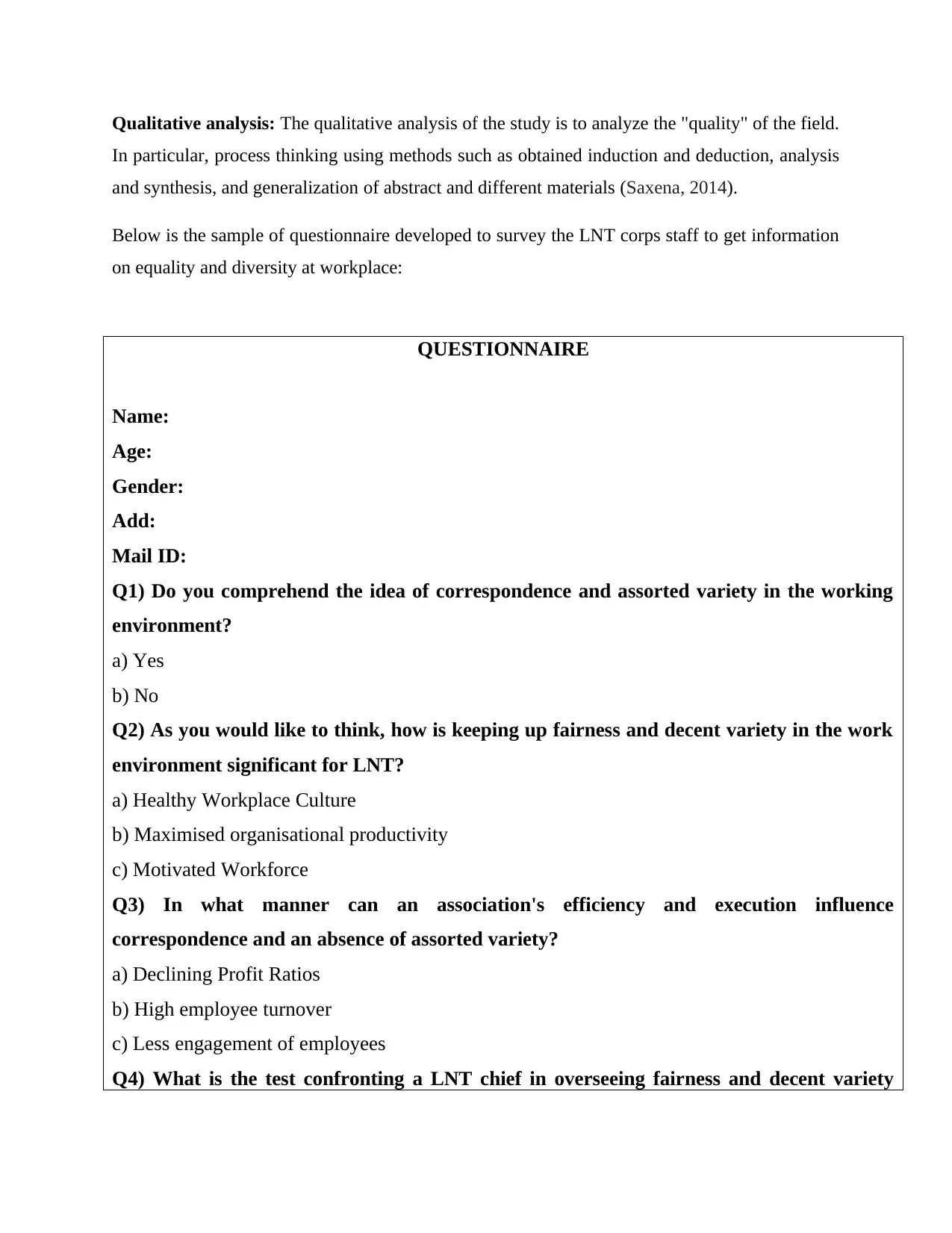
Qualitative analysis: The qualitative analysis of the study is to analyze the "quality" of the field.
In particular, process thinking using methods such as obtained induction and deduction, analysis
and synthesis, and generalization of abstract and different materials (Saxena, 2014).
Below is the sample of questionnaire developed to survey the LNT corps staff to get information
on equality and diversity at workplace:
QUESTIONNAIRE
Name:
Age:
Gender:
Add:
Mail ID:
Q1) Do you comprehend the idea of correspondence and assorted variety in the working
environment?
a) Yes
b) No
Q2) As you would like to think, how is keeping up fairness and decent variety in the work
environment significant for LNT?
a) Healthy Workplace Culture
b) Maximised organisational productivity
c) Motivated Workforce
Q3) In what manner can an association's efficiency and execution influence
correspondence and an absence of assorted variety?
a) Declining Profit Ratios
b) High employee turnover
c) Less engagement of employees
Q4) What is the test confronting a LNT chief in overseeing fairness and decent variety
In particular, process thinking using methods such as obtained induction and deduction, analysis
and synthesis, and generalization of abstract and different materials (Saxena, 2014).
Below is the sample of questionnaire developed to survey the LNT corps staff to get information
on equality and diversity at workplace:
QUESTIONNAIRE
Name:
Age:
Gender:
Add:
Mail ID:
Q1) Do you comprehend the idea of correspondence and assorted variety in the working
environment?
a) Yes
b) No
Q2) As you would like to think, how is keeping up fairness and decent variety in the work
environment significant for LNT?
a) Healthy Workplace Culture
b) Maximised organisational productivity
c) Motivated Workforce
Q3) In what manner can an association's efficiency and execution influence
correspondence and an absence of assorted variety?
a) Declining Profit Ratios
b) High employee turnover
c) Less engagement of employees
Q4) What is the test confronting a LNT chief in overseeing fairness and decent variety
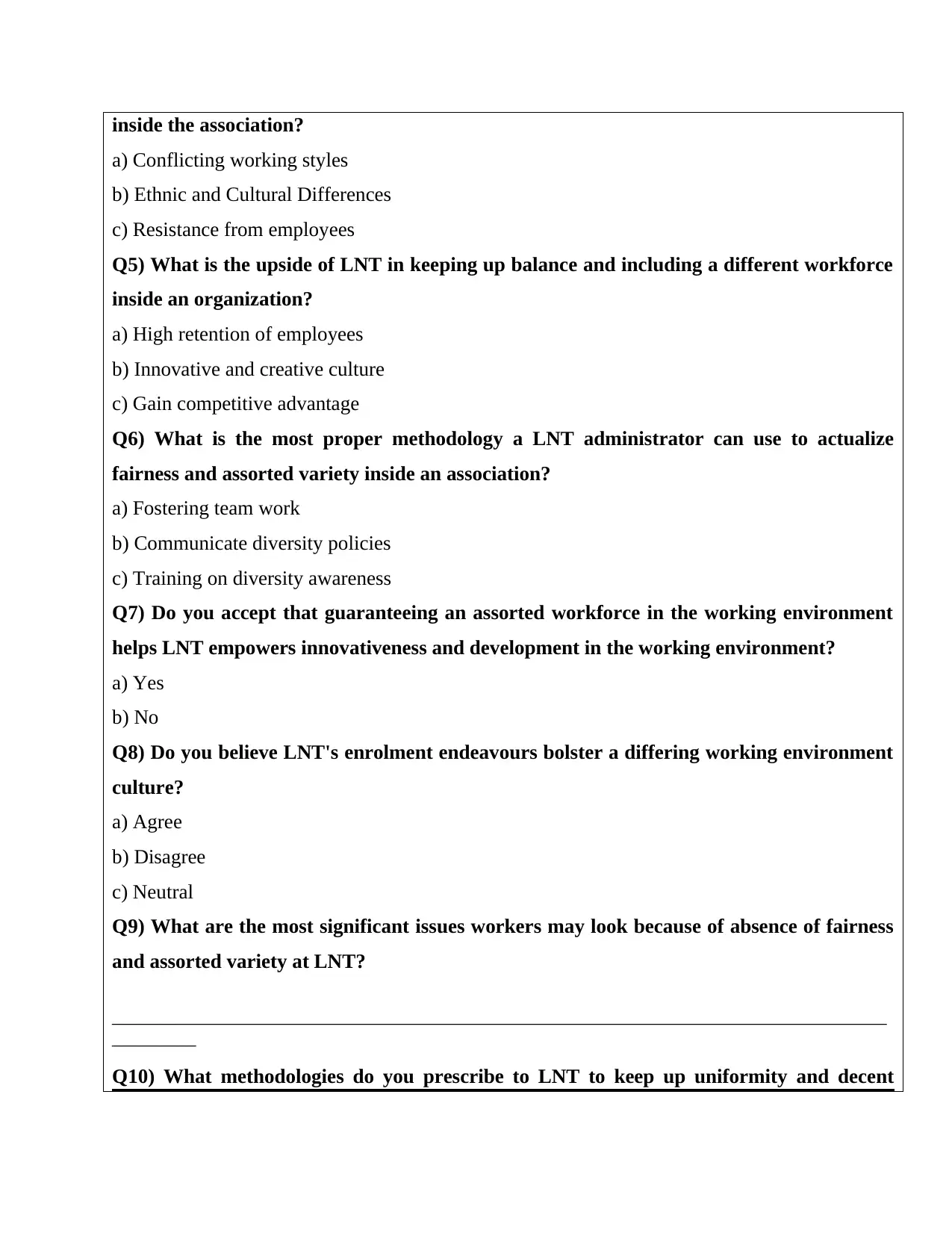
inside the association?
a) Conflicting working styles
b) Ethnic and Cultural Differences
c) Resistance from employees
Q5) What is the upside of LNT in keeping up balance and including a different workforce
inside an organization?
a) High retention of employees
b) Innovative and creative culture
c) Gain competitive advantage
Q6) What is the most proper methodology a LNT administrator can use to actualize
fairness and assorted variety inside an association?
a) Fostering team work
b) Communicate diversity policies
c) Training on diversity awareness
Q7) Do you accept that guaranteeing an assorted workforce in the working environment
helps LNT empowers innovativeness and development in the working environment?
a) Yes
b) No
Q8) Do you believe LNT's enrolment endeavours bolster a differing working environment
culture?
a) Agree
b) Disagree
c) Neutral
Q9) What are the most significant issues workers may look because of absence of fairness
and assorted variety at LNT?
___________________________________________________________________________________
_________
Q10) What methodologies do you prescribe to LNT to keep up uniformity and decent
a) Conflicting working styles
b) Ethnic and Cultural Differences
c) Resistance from employees
Q5) What is the upside of LNT in keeping up balance and including a different workforce
inside an organization?
a) High retention of employees
b) Innovative and creative culture
c) Gain competitive advantage
Q6) What is the most proper methodology a LNT administrator can use to actualize
fairness and assorted variety inside an association?
a) Fostering team work
b) Communicate diversity policies
c) Training on diversity awareness
Q7) Do you accept that guaranteeing an assorted workforce in the working environment
helps LNT empowers innovativeness and development in the working environment?
a) Yes
b) No
Q8) Do you believe LNT's enrolment endeavours bolster a differing working environment
culture?
a) Agree
b) Disagree
c) Neutral
Q9) What are the most significant issues workers may look because of absence of fairness
and assorted variety at LNT?
___________________________________________________________________________________
_________
Q10) What methodologies do you prescribe to LNT to keep up uniformity and decent
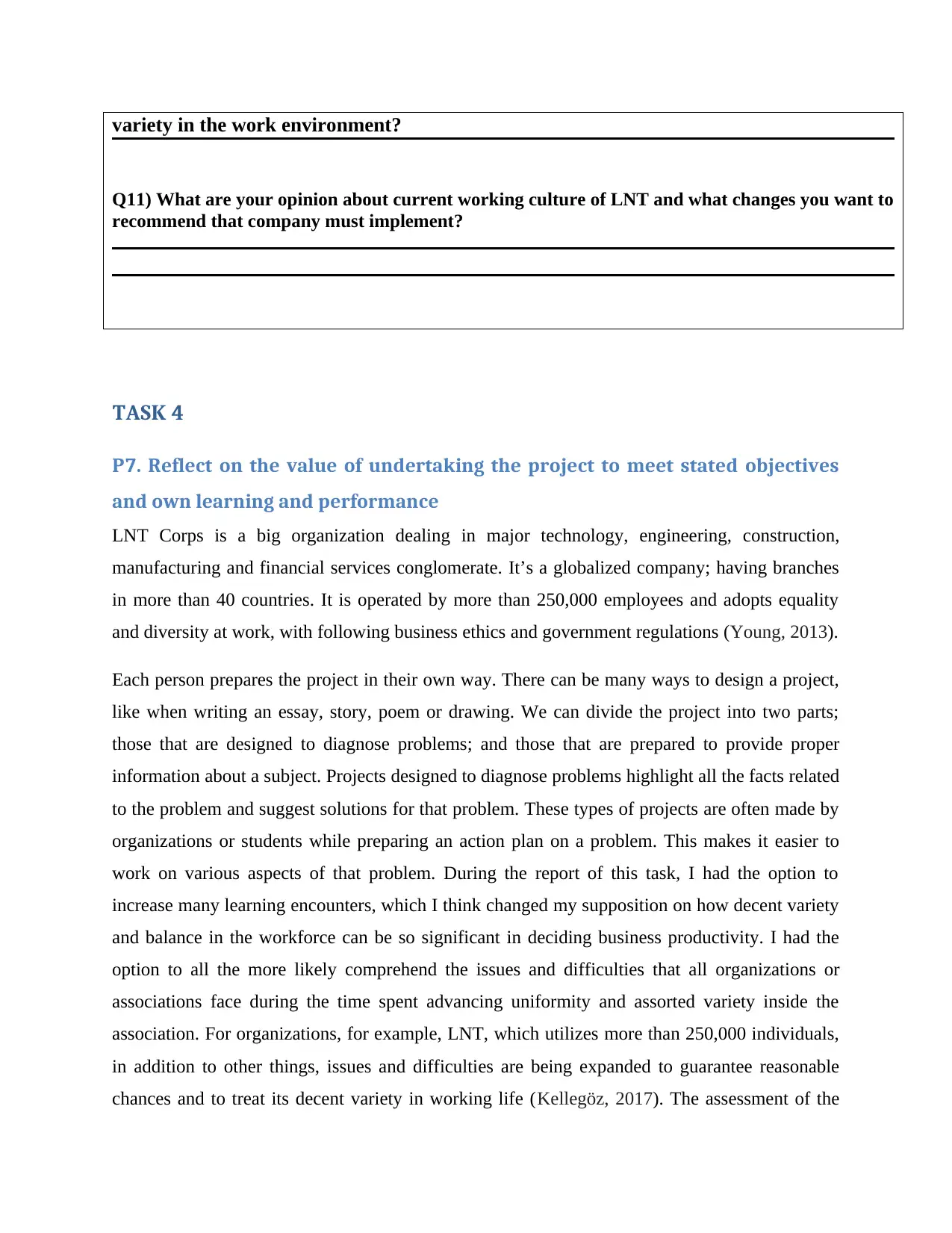
variety in the work environment?
Q11) What are your opinion about current working culture of LNT and what changes you want to
recommend that company must implement?
TASK 4
P7. Reflect on the value of undertaking the project to meet stated objectives
and own learning and performance
LNT Corps is a big organization dealing in major technology, engineering, construction,
manufacturing and financial services conglomerate. It’s a globalized company; having branches
in more than 40 countries. It is operated by more than 250,000 employees and adopts equality
and diversity at work, with following business ethics and government regulations (Young, 2013).
Each person prepares the project in their own way. There can be many ways to design a project,
like when writing an essay, story, poem or drawing. We can divide the project into two parts;
those that are designed to diagnose problems; and those that are prepared to provide proper
information about a subject. Projects designed to diagnose problems highlight all the facts related
to the problem and suggest solutions for that problem. These types of projects are often made by
organizations or students while preparing an action plan on a problem. This makes it easier to
work on various aspects of that problem. During the report of this task, I had the option to
increase many learning encounters, which I think changed my supposition on how decent variety
and balance in the workforce can be so significant in deciding business productivity. I had the
option to all the more likely comprehend the issues and difficulties that all organizations or
associations face during the time spent advancing uniformity and assorted variety inside the
association. For organizations, for example, LNT, which utilizes more than 250,000 individuals,
in addition to other things, issues and difficulties are being expanded to guarantee reasonable
chances and to treat its decent variety in working life (Kellegöz, 2017). The assessment of the
Q11) What are your opinion about current working culture of LNT and what changes you want to
recommend that company must implement?
TASK 4
P7. Reflect on the value of undertaking the project to meet stated objectives
and own learning and performance
LNT Corps is a big organization dealing in major technology, engineering, construction,
manufacturing and financial services conglomerate. It’s a globalized company; having branches
in more than 40 countries. It is operated by more than 250,000 employees and adopts equality
and diversity at work, with following business ethics and government regulations (Young, 2013).
Each person prepares the project in their own way. There can be many ways to design a project,
like when writing an essay, story, poem or drawing. We can divide the project into two parts;
those that are designed to diagnose problems; and those that are prepared to provide proper
information about a subject. Projects designed to diagnose problems highlight all the facts related
to the problem and suggest solutions for that problem. These types of projects are often made by
organizations or students while preparing an action plan on a problem. This makes it easier to
work on various aspects of that problem. During the report of this task, I had the option to
increase many learning encounters, which I think changed my supposition on how decent variety
and balance in the workforce can be so significant in deciding business productivity. I had the
option to all the more likely comprehend the issues and difficulties that all organizations or
associations face during the time spent advancing uniformity and assorted variety inside the
association. For organizations, for example, LNT, which utilizes more than 250,000 individuals,
in addition to other things, issues and difficulties are being expanded to guarantee reasonable
chances and to treat its decent variety in working life (Kellegöz, 2017). The assessment of the
Paraphrase This Document
Need a fresh take? Get an instant paraphrase of this document with our AI Paraphraser
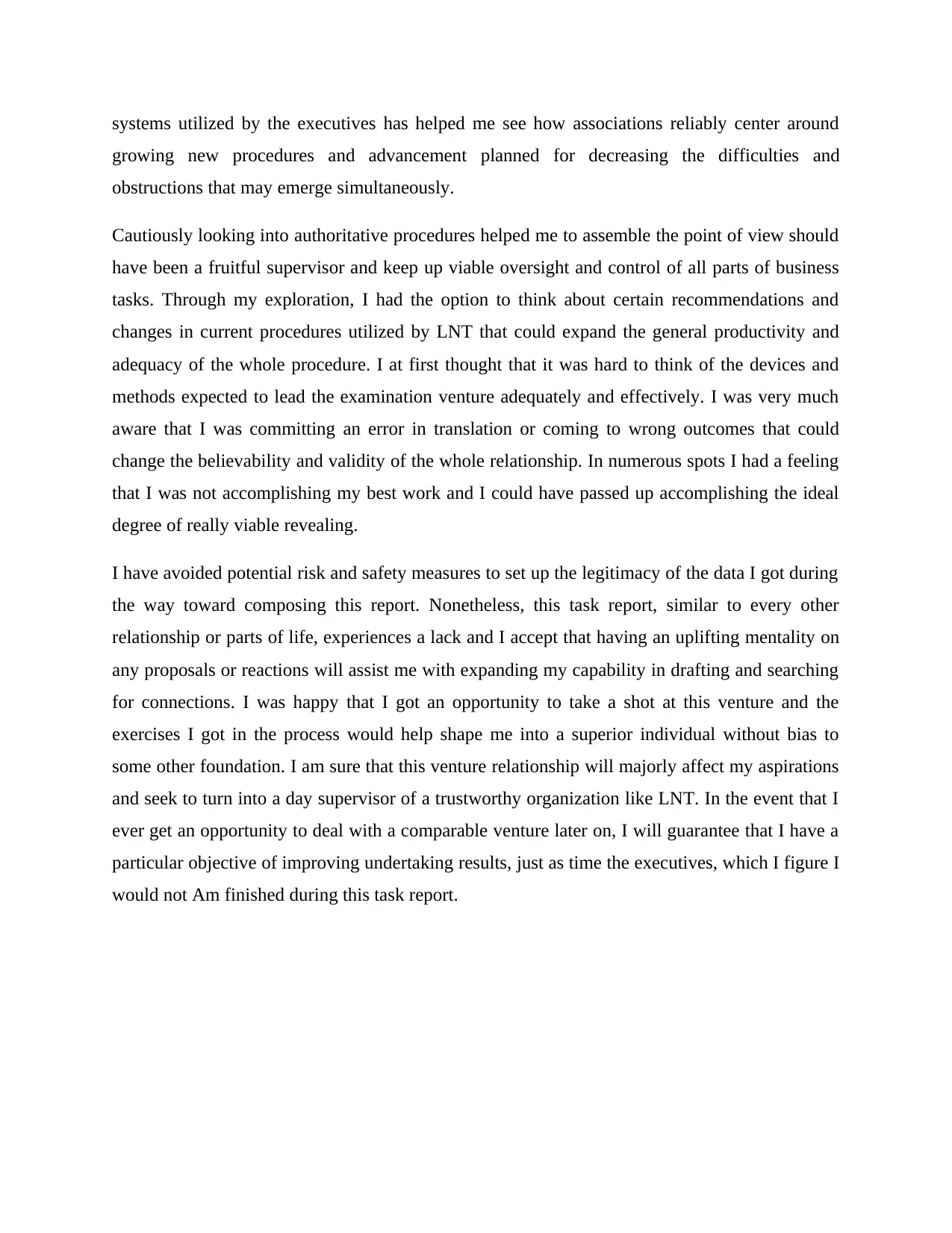
systems utilized by the executives has helped me see how associations reliably center around
growing new procedures and advancement planned for decreasing the difficulties and
obstructions that may emerge simultaneously.
Cautiously looking into authoritative procedures helped me to assemble the point of view should
have been a fruitful supervisor and keep up viable oversight and control of all parts of business
tasks. Through my exploration, I had the option to think about certain recommendations and
changes in current procedures utilized by LNT that could expand the general productivity and
adequacy of the whole procedure. I at first thought that it was hard to think of the devices and
methods expected to lead the examination venture adequately and effectively. I was very much
aware that I was committing an error in translation or coming to wrong outcomes that could
change the believability and validity of the whole relationship. In numerous spots I had a feeling
that I was not accomplishing my best work and I could have passed up accomplishing the ideal
degree of really viable revealing.
I have avoided potential risk and safety measures to set up the legitimacy of the data I got during
the way toward composing this report. Nonetheless, this task report, similar to every other
relationship or parts of life, experiences a lack and I accept that having an uplifting mentality on
any proposals or reactions will assist me with expanding my capability in drafting and searching
for connections. I was happy that I got an opportunity to take a shot at this venture and the
exercises I got in the process would help shape me into a superior individual without bias to
some other foundation. I am sure that this venture relationship will majorly affect my aspirations
and seek to turn into a day supervisor of a trustworthy organization like LNT. In the event that I
ever get an opportunity to deal with a comparable venture later on, I will guarantee that I have a
particular objective of improving undertaking results, just as time the executives, which I figure I
would not Am finished during this task report.
growing new procedures and advancement planned for decreasing the difficulties and
obstructions that may emerge simultaneously.
Cautiously looking into authoritative procedures helped me to assemble the point of view should
have been a fruitful supervisor and keep up viable oversight and control of all parts of business
tasks. Through my exploration, I had the option to think about certain recommendations and
changes in current procedures utilized by LNT that could expand the general productivity and
adequacy of the whole procedure. I at first thought that it was hard to think of the devices and
methods expected to lead the examination venture adequately and effectively. I was very much
aware that I was committing an error in translation or coming to wrong outcomes that could
change the believability and validity of the whole relationship. In numerous spots I had a feeling
that I was not accomplishing my best work and I could have passed up accomplishing the ideal
degree of really viable revealing.
I have avoided potential risk and safety measures to set up the legitimacy of the data I got during
the way toward composing this report. Nonetheless, this task report, similar to every other
relationship or parts of life, experiences a lack and I accept that having an uplifting mentality on
any proposals or reactions will assist me with expanding my capability in drafting and searching
for connections. I was happy that I got an opportunity to take a shot at this venture and the
exercises I got in the process would help shape me into a superior individual without bias to
some other foundation. I am sure that this venture relationship will majorly affect my aspirations
and seek to turn into a day supervisor of a trustworthy organization like LNT. In the event that I
ever get an opportunity to deal with a comparable venture later on, I will guarantee that I have a
particular objective of improving undertaking results, just as time the executives, which I figure I
would not Am finished during this task report.
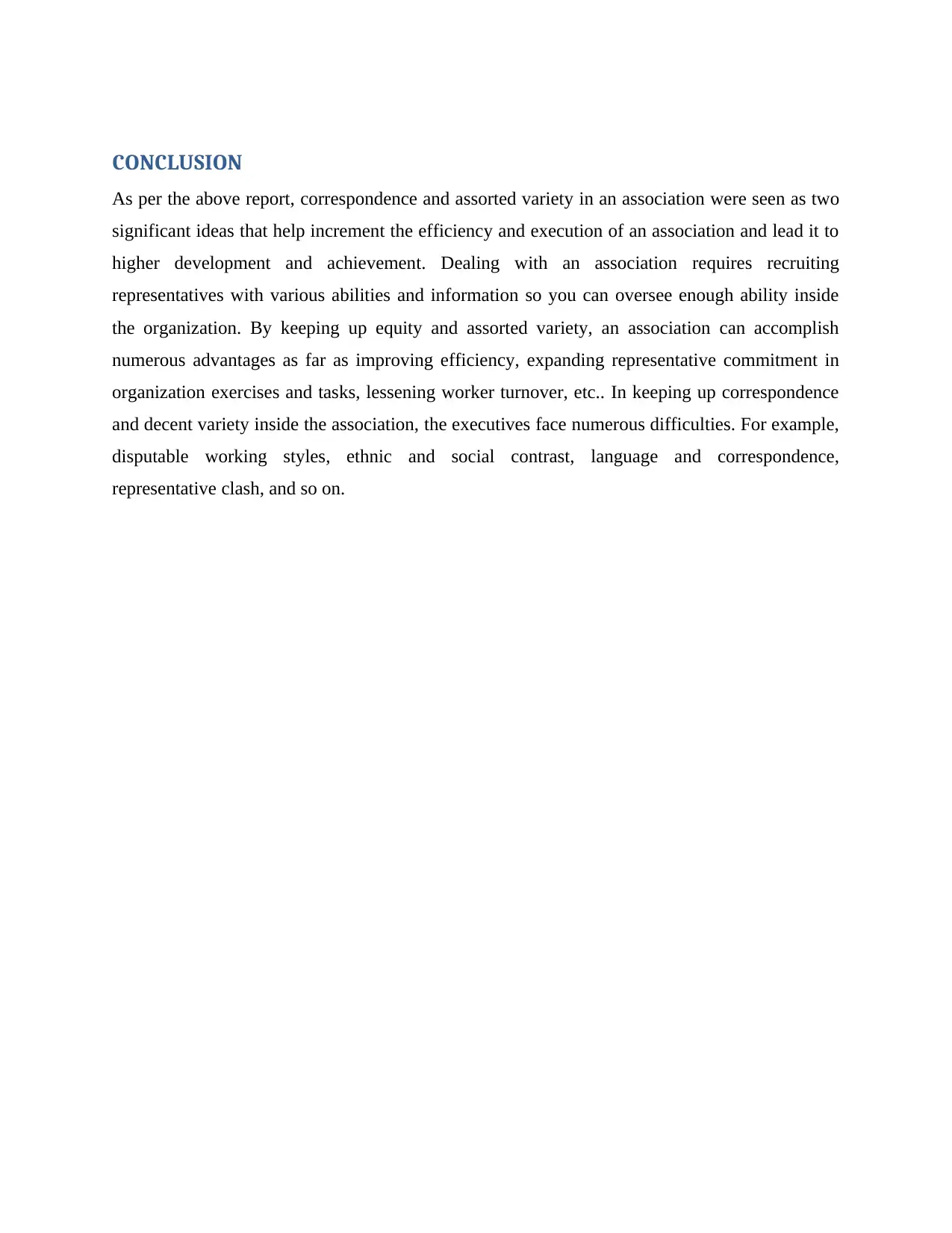
CONCLUSION
As per the above report, correspondence and assorted variety in an association were seen as two
significant ideas that help increment the efficiency and execution of an association and lead it to
higher development and achievement. Dealing with an association requires recruiting
representatives with various abilities and information so you can oversee enough ability inside
the organization. By keeping up equity and assorted variety, an association can accomplish
numerous advantages as far as improving efficiency, expanding representative commitment in
organization exercises and tasks, lessening worker turnover, etc.. In keeping up correspondence
and decent variety inside the association, the executives face numerous difficulties. For example,
disputable working styles, ethnic and social contrast, language and correspondence,
representative clash, and so on.
As per the above report, correspondence and assorted variety in an association were seen as two
significant ideas that help increment the efficiency and execution of an association and lead it to
higher development and achievement. Dealing with an association requires recruiting
representatives with various abilities and information so you can oversee enough ability inside
the organization. By keeping up equity and assorted variety, an association can accomplish
numerous advantages as far as improving efficiency, expanding representative commitment in
organization exercises and tasks, lessening worker turnover, etc.. In keeping up correspondence
and decent variety inside the association, the executives face numerous difficulties. For example,
disputable working styles, ethnic and social contrast, language and correspondence,
representative clash, and so on.
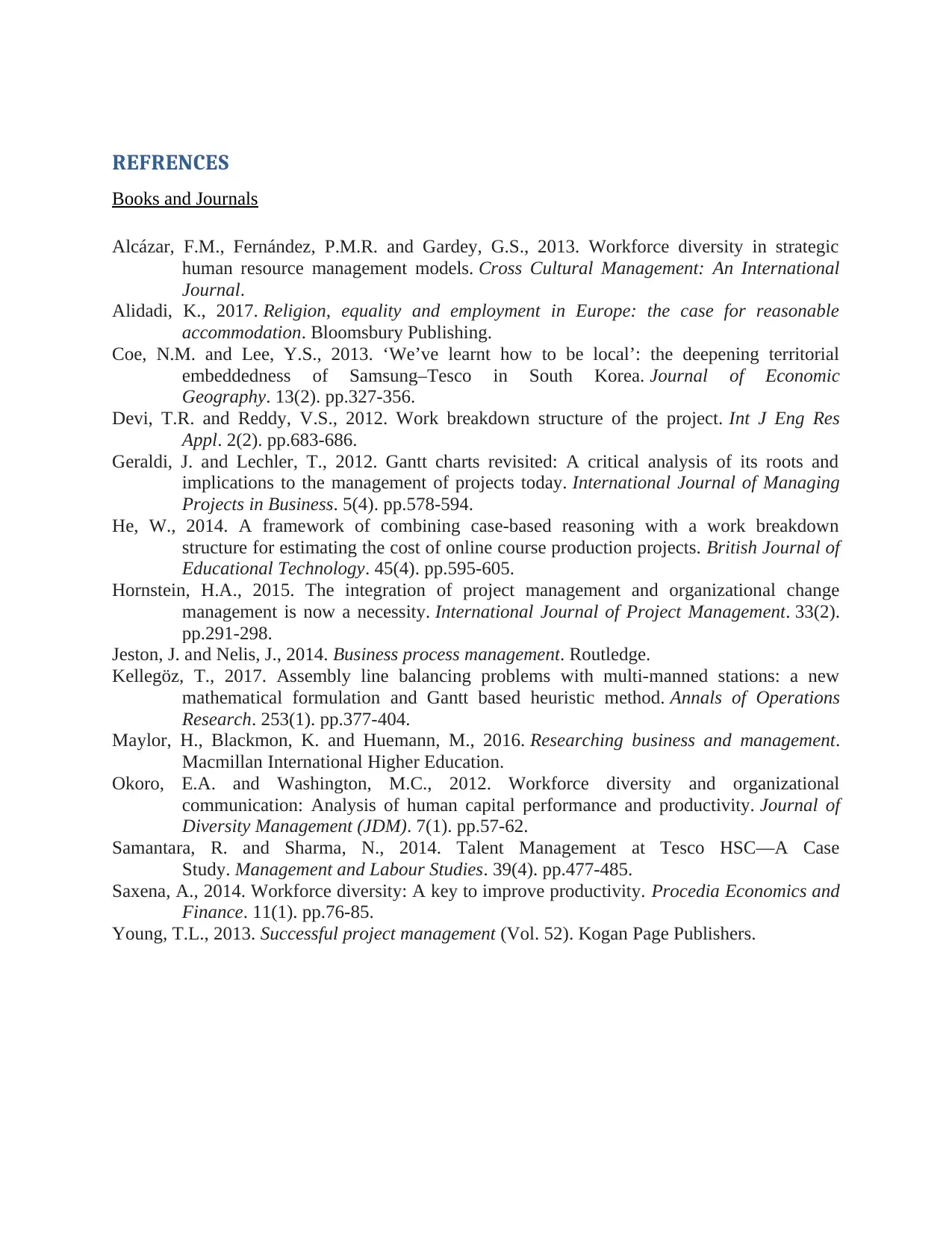
REFRENCES
Books and Journals
Alcázar, F.M., Fernández, P.M.R. and Gardey, G.S., 2013. Workforce diversity in strategic
human resource management models. Cross Cultural Management: An International
Journal.
Alidadi, K., 2017. Religion, equality and employment in Europe: the case for reasonable
accommodation. Bloomsbury Publishing.
Coe, N.M. and Lee, Y.S., 2013. ‘We’ve learnt how to be local’: the deepening territorial
embeddedness of Samsung–Tesco in South Korea. Journal of Economic
Geography. 13(2). pp.327-356.
Devi, T.R. and Reddy, V.S., 2012. Work breakdown structure of the project. Int J Eng Res
Appl. 2(2). pp.683-686.
Geraldi, J. and Lechler, T., 2012. Gantt charts revisited: A critical analysis of its roots and
implications to the management of projects today. International Journal of Managing
Projects in Business. 5(4). pp.578-594.
He, W., 2014. A framework of combining case‐based reasoning with a work breakdown
structure for estimating the cost of online course production projects. British Journal of
Educational Technology. 45(4). pp.595-605.
Hornstein, H.A., 2015. The integration of project management and organizational change
management is now a necessity. International Journal of Project Management. 33(2).
pp.291-298.
Jeston, J. and Nelis, J., 2014. Business process management. Routledge.
Kellegöz, T., 2017. Assembly line balancing problems with multi-manned stations: a new
mathematical formulation and Gantt based heuristic method. Annals of Operations
Research. 253(1). pp.377-404.
Maylor, H., Blackmon, K. and Huemann, M., 2016. Researching business and management.
Macmillan International Higher Education.
Okoro, E.A. and Washington, M.C., 2012. Workforce diversity and organizational
communication: Analysis of human capital performance and productivity. Journal of
Diversity Management (JDM). 7(1). pp.57-62.
Samantara, R. and Sharma, N., 2014. Talent Management at Tesco HSC—A Case
Study. Management and Labour Studies. 39(4). pp.477-485.
Saxena, A., 2014. Workforce diversity: A key to improve productivity. Procedia Economics and
Finance. 11(1). pp.76-85.
Young, T.L., 2013. Successful project management (Vol. 52). Kogan Page Publishers.
Books and Journals
Alcázar, F.M., Fernández, P.M.R. and Gardey, G.S., 2013. Workforce diversity in strategic
human resource management models. Cross Cultural Management: An International
Journal.
Alidadi, K., 2017. Religion, equality and employment in Europe: the case for reasonable
accommodation. Bloomsbury Publishing.
Coe, N.M. and Lee, Y.S., 2013. ‘We’ve learnt how to be local’: the deepening territorial
embeddedness of Samsung–Tesco in South Korea. Journal of Economic
Geography. 13(2). pp.327-356.
Devi, T.R. and Reddy, V.S., 2012. Work breakdown structure of the project. Int J Eng Res
Appl. 2(2). pp.683-686.
Geraldi, J. and Lechler, T., 2012. Gantt charts revisited: A critical analysis of its roots and
implications to the management of projects today. International Journal of Managing
Projects in Business. 5(4). pp.578-594.
He, W., 2014. A framework of combining case‐based reasoning with a work breakdown
structure for estimating the cost of online course production projects. British Journal of
Educational Technology. 45(4). pp.595-605.
Hornstein, H.A., 2015. The integration of project management and organizational change
management is now a necessity. International Journal of Project Management. 33(2).
pp.291-298.
Jeston, J. and Nelis, J., 2014. Business process management. Routledge.
Kellegöz, T., 2017. Assembly line balancing problems with multi-manned stations: a new
mathematical formulation and Gantt based heuristic method. Annals of Operations
Research. 253(1). pp.377-404.
Maylor, H., Blackmon, K. and Huemann, M., 2016. Researching business and management.
Macmillan International Higher Education.
Okoro, E.A. and Washington, M.C., 2012. Workforce diversity and organizational
communication: Analysis of human capital performance and productivity. Journal of
Diversity Management (JDM). 7(1). pp.57-62.
Samantara, R. and Sharma, N., 2014. Talent Management at Tesco HSC—A Case
Study. Management and Labour Studies. 39(4). pp.477-485.
Saxena, A., 2014. Workforce diversity: A key to improve productivity. Procedia Economics and
Finance. 11(1). pp.76-85.
Young, T.L., 2013. Successful project management (Vol. 52). Kogan Page Publishers.
Secure Best Marks with AI Grader
Need help grading? Try our AI Grader for instant feedback on your assignments.

1 out of 17
Related Documents
Your All-in-One AI-Powered Toolkit for Academic Success.
+13062052269
info@desklib.com
Available 24*7 on WhatsApp / Email
![[object Object]](/_next/static/media/star-bottom.7253800d.svg)
Unlock your academic potential
© 2024 | Zucol Services PVT LTD | All rights reserved.





